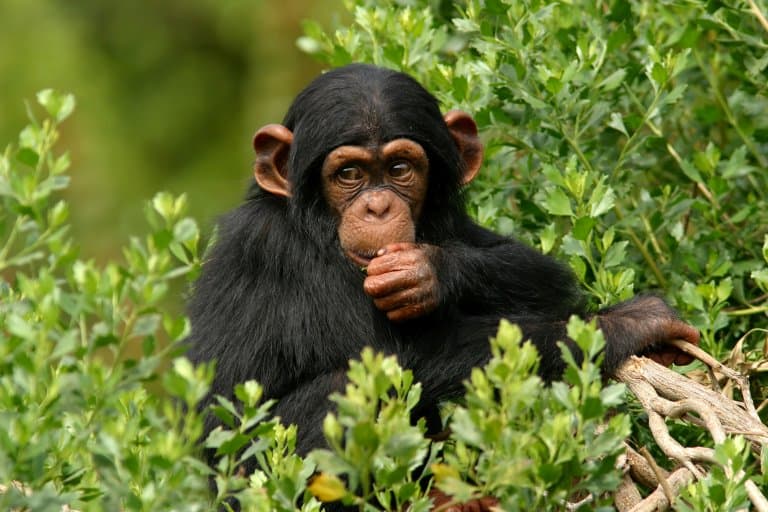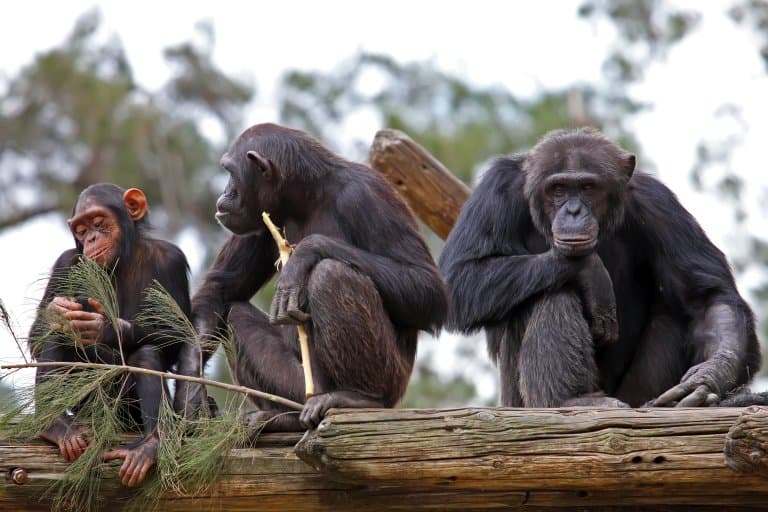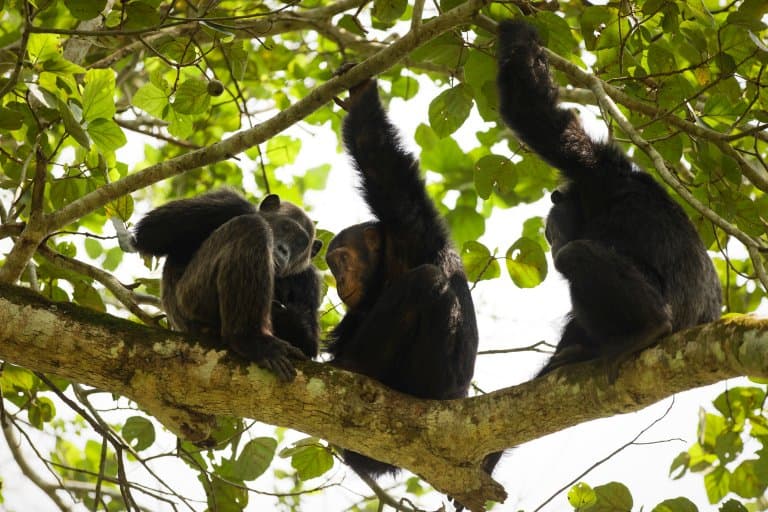Chimpanzee Profile
The chimpanzee is a great ape known for being the closest living relative of humans.
They share approximately 99% of our genes and it is believed we share a common ancestor that lived seven to 13 million years ago.
In groups called communities, chimpanzees predominantly inhabit tropical forests and savannas in Central and West Africa. These communities are highly social, led by an alpha male chimp and often contain several dozen animals.

Chimpanzee Facts Overview
| Habitat: | Tropical forests, savannas |
| Location: | Central and West Africa |
| Lifespan: | Approximately 15 years in the wild, but can live up to 30. Up to 40 on average in captivity |
| Size: | 4 to 5.5 feet in height |
| Weight: | 30 – 70 kg (60 to 150 pounds) |
| Color: | Brown or black hair with bare faces and hands |
| Diet: | Fruits, seeds, nuts, flowers, insects, eggs |
| Predators: | Leopards, eagles, snakes |
| Top Speed: | 40 kilometers per hour |
| No. of Species: | 1 |
| Conservation Status: | Endangered |
Chimpanzees known as ‘chimps’ can only be found in the wild in Africa, and they inhabit around 21 countries across the continent, where there are rainforests, water and fruit.
There is a single species of chimp, with 4 subspecies – the Central chimpanzee, Western chimpanzee, Nigeria-Cameroon chimpanzee and Eastern chimpanzee. A fifth subspecies has been proposed and is known as the Southeastern chimpanzee.
Chimps are a close relative to the bonobo, who are commonly known as the pygmy chimpanzee. They are the only other species in the same genus ‘Pan’, as chimps.
They are omnivores, meaning they eat both meat and vegetation. They will eat fruit, flowers, leaves, seeds, honey and insects. They sleep in trees and build nests to rest on.
The IUCN has categorized the chimpanzee as an endangered species with a decreasing trend. This is largely due to logging, mining, oil extraction, and the encroachment of the human population into forests and grasslands.
As the human population continues to grow, chimpanzee populations will be at an even greater risk of extinction. Greater conservation efforts, such as those outlined in the U.S. Endangered Species Act, will be needed to protect habitats, raise sanctuaries, and put a stop to illegal hunting practices.
There are estimated to be between 170,000 – 300,000 chimps living in the wild across Africa.
Interesting Chimpanzee Facts
1. They are one of the few species that are capable of using tools
Chimpanzees are famous for their keen minds. Evidence of their intelligence was documented in the 1960s when Jane Goodall witnessed their use of tools to hunt insects and gather food.
In a 2007 study, researchers gave adult chimps, teenage chimps, and college students an identical cognitive test, which involved remembering where nine numbers on a touchscreen monitor were situated after seeing the numbers on the screen for 650, 430, or 210 milliseconds.
Adult chimps and college students fared similarly, while adolescent chimps performed significantly better, recalling the locations of the numbers in the correct order with far more accuracy.
Read more in our smartest animals in the world piece. 1
2. Communities can grow large!
While communities typically consist of approximately 20 chimpanzees, they can grow up to well over 100 members. 2
3. Chimpanzees have been witnessed hunting other chimpanzees and monkeys
Chimpanzees have shockingly been observed participating in infanticide, which is the practice of killing one’s own or another’s young. They have also been seen hunting other primates, such as baboons.
4. They can live up to 80 years old
The oldest recorded chimpanzee was between 76 and 82 when she passed away, which far surpasses the current life expectancy of 33 years for wild chimps.
Lifespan is hard to gauge for chimpanzees due to their diverse populations and variation in habitats. 3

5. They communicate using a fascinating collection of vocalizations
Thus far, it has been determined that chimpanzees can make approximately 30 distinct vocalizations.
They pant, hoot, and howl to interact with their family and peers.
6. They can also use sign language
Numerous researchers have taught chimpanzees to use sign language. Using this method of communication, they have been taught how to solve many kinds of puzzles and problems.
Washoe, a chimp, was the first non-human to learn to communicate using American Sign Language (ASL) and could do over 350 signs. Later on, Washoe was able to pass on certain indications to her adopted kid.4
7. Chimpanzees can get quite aggressive
To maintain dominance, alpha males will organize and carry out attacks on other chimps which can end in severe injuries and even death.
Aggression against humans has also been reported, especially at the edge of forests.
8. Hierarchal relationships within groups are fluid and complex
Communities comprise almost twice as many females as males and are led by a dominant (alpha) male.
Each community can be further divided into smaller groups called parties, which can vary in makeup, roles, and size. Members of parties are free to separate from and join other parties freely, so relationships are constantly shifting.

9. They are 1.5 times stronger than humans comparatively
Compared to a similar-sized human, a chimpanzee will be approximately 1.5 times stronger than their human counterpart.
They swing from branch to branch with ease with bodies that contain a much higher proportion of fast twitch muscle fibres.
This is one of the chimps special adaptations for climbing and swinging alongside feet that are adapted for grasping with an opposable big toe.
10. Different communities have different cultures
Elders will pass on their knowledge, skills, and behaviors to younger chimps. The transmission of information varies between communities and from generation to generation within a group.
11. Their ears are more sensitive to high-frequency sounds than humans are
Previous studies have shown that chimpanzees are sensitive to tones of about 33 000 Hz while human subjects can only detect tones of up to 24 000 Hz.
This may be due to the types of sounds they are used to sensing in their natural environments.

12. They can walk on two legs
Like humans, chimpanzees can walk upright on the rare occassion, but they prefer swinging through branches, or walking on all fours (also known as knuckle-walking, like gorillas).
The arms of a chimp are longer than its legs and can reach below the knees.
13. They can give birth at any time of the year
Females reach reproductive maturity at around 13 years of age. After a gestation period of about eight months, chimps usually give birth to a single infant about once every 5 years.
Young chimps will cling to their mothers back until the age of 3-5 years.
14. Young chimps will stay with their mothers for several years
Mothers will care their young for a couple of years until the chimps are ready to live on their own. During this time, baby chimpanzees hang onto their mothers or ride on their backs until they are about 4 years old.

15. Despite their similarities to humans, they do not make good pets
As mentioned above, chimpanzees are inherently violent animals.
Human environments are likely not stimulating enough for their wild natures. They are destructive and should not be kept as pets.
16. They continue to be hunted for meat
Unfortunately, chimpanzees are still being hunted for bushmeat. To hunters, they are appealing as prey because of their size and meat. 5
Chimpanzee Fact-File Summary
Chimpanzee Classification
| Kingdom | Animalia |
| Phylum | Chordata |
| Class | Mammalia |
| Order | Primates |
| Family | Hominidae |
| Genus | Pan |
| Species | Pan Troglodytes |
Fact Sources & References
- Rowan Hooper (2007), “Chimps outperform humans at memory task“, Nature.com
- Joel Sartore (2023), “Chimpanzee”, National Geographic.
- Toshisada Nishida (1999), “Chimpanzee”, Britannica.
- Olivia Lai (Year), “10 Facts About Chimpanzees”, Earth.
- Roisin McDonough, “Chimpanzee guide: where they live, what they eat, and how they use tools and weapons”, BBC Wildlife.
